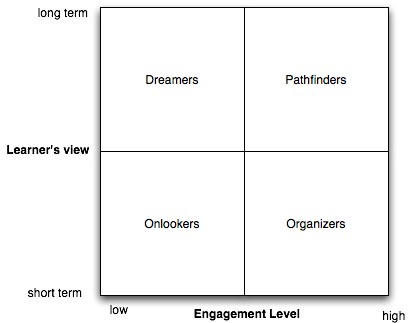Instructional Design —A Learner's Framework
Bill Moggridge (2007) writes about a framework that is geared towards developing web interfaces by showing a person's needs and behavior for a particular project or task. This framework could also be used for learners. This framework is a two-by-two matrix with a vertical axis describing the view of the learner, with a long-term view at the top and a short-term view at the bottom. The horizontal axis shows how engaged the learner is, with low engagement on the left and high engagement on the right:
- In the top right hand corner are Pathfinders who are fully engaged and take a long term perspective.
- Below them, in the bottom right-hand corner, are Organizers who are highly engaged but take a short term view.
- Next door to them, in the bottom left-hand corner, are Onlookers who take a short term view and have low engagement.
- Above them, in the upper left-hand corner, are Dreamers who have a long term view, but have low engagement.
A Pathfinder is someone who really needs to learn the task because she is going to be using it for the long-term and will be fully engaged during the entire time frame. Training or a blended platform will normally be called for and if the task is highly complex, an in-depth performance support package might also be needed.
Organizers are engaged by the task, but don't view themselves as being the primary task-holders. They might be a supervisor who needs to learn about the task, a person who will fill in part-time as a backup, or the task might simply be for the short-term. A just-in-time learning package, such as elearning might be used to give them the basic knowledge, followed by a highly detailed support package (job-Performance-Aid) that allows them to perform at the minimal requirements for a short period of time if needed.
Onlookers are not fully engaged in learning the task because they will not be performing the task; however, they are fully engaged in other closely related tasks, thus they need to see how that task relates to them. A basic elearning package that gives an overview of the task and how it relates to the organization might be a proper fit.
Daydreamers have a long term view because they see it as a means to something else, rather than an end; for example, a means to do another task or job. However, they do not want to waste a lot of time learning the task, thus a quick and dirty elearning or the cheapest performance support band-aid available

No comments:
Post a Comment